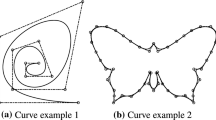Abstract
Progressive-iterative approximation (abbr. PIA) is an important and intuitive method for fitting and interpolating scattered data points. The triangular Bernstein basis with uniformly distributed parameters has the PIA property. For the sake of more flexibility, this paper presents a local progressive-iterative approximation (abbr. LPIA) format, which allows only a chosen subset of the initial control points to adjust and shows that the LPIA format is convergent for triangular Bézier surface of degree \(n \le 17\) with uniform parameters. Furthermore, in order to accelerate the convergence rate, we develop a weighted LPIA format for triangular Bézier surfaces and prove that the weighted LPIA format has a faster convergence rate than the LPIA format when an optimal value of the weight is chosen. Finally, some numerical examples are presented to show the effectiveness of the LPIA method and the fast convergence of the weighted LPIA method.







Similar content being viewed by others
References
Qi, D., Tian, Z., Zhang, Y., et al.: The method of numeric polish in curve fitting. Acta Math. Sin. (Chin. Ser.) 18(3), 173–184 (1975)
de Boor, C.: How does Agee’s smoothing method work? In: Proceedings of the 1979 Army Numerical Analysis and Computers Conference, ARO Report 79–3, Army Research Office, 1979, pp. 299–302
Lin, H.W., Wang, G.J., Dong, C.S.: Constructing iterative non-uniform B-spline curve and surface to fit data points. Sci. China Ser. F Inf. Sci. 47(3), 315–331 (2004)
Lin, H.W., Bao, H.J., Wang, G.J.: Totally positive bases and progressive iteration approximation. Comput. Math. Appl. 50(3–4), 575–586 (2005)
Shi, L., Wang, R.H.: An iterative algorithm of NURBS interpolation and approximation. J. Math. Res. Expos. 26(4), 735–743 (2006)
Delgado, J., Peňa, J.M.: Progressive iterative approximation and bases with the fastest convergence rates. Comput. Aided Geom. Des. 24(1), 10–18 (2007)
Lu, L.Z.: Weighted progressive iteration approximation and convergence analysis. Comput. Aided Geom. Des. 27, 129–137 (2010)
Deng, C.Y., Lin, H.W.: Progressive and iterative approximation for least squares B-spline curve and surface fitting. Comput. Aided Des. 47, 32–44 (2014)
Zhang, L., Tan, J.Q., Ge, X.Y., et al.: Generalized B-splines’ geometric iterative fitting method with mutually different weights. J. Comput. Appl. Math. 329, 331–343 (2018)
Zhang, L., Ge, X.Y., Tan, J.Q.: Least square geometric iterative fitting method for generalized B-spline curves with two different kinds of weights. Vis. Comput. 32(9), 1109–1120 (2016)
Ebrahimi, A., Loghmani, G.B.: A composite iterative procedure with fast convergence rate for the progressive-iteration approximation of curves. J. Comput. Appl. Math. 359, 1–15 (2019)
Lin, H.W.: Local progressive-iterative approximation format for blending curves and patches. Comput. Aided Geom. Des. 27, 322–339 (2010)
Farin, G.: Curves and Surfaces for CAGD, 5th end. Morgan Kaufmann, San Francisco (2001)
Hahmann, S., Bonneau, G.P.: Triangular G1 interpolation by 4-splitting domain triangles. Comput. Aided Geom. Des. 17(8), 731–757 (2000)
Chen, J., Wang, G.J.: Progressive iterative approximation for triangular Bézier surfaces. Comput. Aided Des. 43, 889–895 (2011)
Hu, Q.Q.: An iterative algorithm for polynomial approximation of rational triangular Bézier surfaces. Appl. Math. Comput. 219, 9308–9316 (2013)
Liu, C.Z., Han, X.L., Li, J.C.: Preconditioned progressive iterative approximation for triangular Bézier patches and its application. J. Comput. Appl. Math. 366, 112389 (2020)
Zhao Y., Lin H.W.: The PIA property of low degree non-uniform triangular B–B patches. Proceedings of the 12th International Conference on Computer-Aided Design and Computer Graphics. IEEE Compute Society Press, Los Alamitos, pp 239–243 (2011).
Hu, Q.Q., Zhang, Y.H., Wang, G.J.: The least square progressive iterative approximation property of low degree non-uniform triangular Bézier surfaces. J. Comput. Aided Design Comput. Graphics 32(3), 360–366 (2020). ((In Chinese))
Dunll, C., Xu, Y.: Orthogonal Polynomial of Several Variables. Cambridge University Press, Cambridge (2001)
Jaklič, G., Kanduč, T.: On positivity of principal minors of bivariate Bézier collocation matrix. Appl. Math. Comput. 227(15), 320–328 (2014)
Varga, R.S.: Matrix Iterative Analysis, 2nd edn. Springer, New York (2000)
Farin, G.: The octant of a sphere as a non-degenerate triangular Bézier patch. Comput. Aided Geom. Des. 4, 329–332 (1987)
Lai, M.J., Schumaker, L.L.: Spline Functions on Triangulation. Cambridge University Press, Cambridge (2007)
Acknowledgements
The authors thank the anonymous referees for their valuable suggestions and comments. This work is supported by the National Natural Science Foundation of China (Grant Nos 61772025, 61872316), the Natural Science Foundation of Zhejiang Province, China (No. LY19F020004).
Author information
Authors and Affiliations
Corresponding author
Additional information
Publisher's Note
Springer Nature remains neutral with regard to jurisdictional claims in published maps and institutional affiliations.
Appendix A. Main symbol table
Appendix A. Main symbol table
\({I}_{n}\) | The set of all 3-composition of the integer n |
|---|---|
\(\Gamma\) | The set of the multi-index of the adjusted control points |
\(\Phi\) | The set of the multi-index of the fixed control points |
\(D_{{n,T}}\) | \(\{ ({i \mathord{\left/ {\vphantom {i n}} \right. \kern-\nulldelimiterspace} n},{j \mathord{\left/ {\vphantom {j n}} \right. \kern-\nulldelimiterspace} n},{k \mathord{\left/ {\vphantom {k n}} \right. \kern-\nulldelimiterspace} n}):(i,j,k) \in {I}_{n} \}\) |
\({\mathbf{\xi }}_{{\mathbf{i}}}\) | The uniformly distributed parameter of the control points |
\({\mathbf{R}}_{{\mathbf{i}}}\) | The initial data points |
\({\mathbf{R}}_{{\mathbf{s}}}^{k}\) | The adjusted control points after the k-th iteration |
\({\mathbf{R}}_{{\mathbf{h}}}^{k}\) | The fixed control points after the k-th iteration |
\(\Delta _{{\mathbf{s}}}^{k}\) | The adjusting vectors after the k-th iteration |
\(\Delta _{{\mathbf{h}}}^{k}\) | The difference vectors after the k-th iteration |
B | The collocation matrix with uniformly distributed parameters |
\({\mathbf{R}}^{k} ( \cdot )\) | The iterative B-B surface after the k-th iteration with LPIA method |
\({\mathbf{R}}_{\omega }^{k} ( \cdot )\) | The iterative B-B surface after the k-th iteration with weighted LPIA method |
Rights and permissions
About this article
Cite this article
Hu, Q., Wang, J. & Liang, R. Weighted local progressive-iterative approximation property for triangular Bézier surfaces. Vis Comput 38, 3819–3830 (2022). https://doi.org/10.1007/s00371-021-02223-1
Accepted:
Published:
Issue Date:
DOI: https://doi.org/10.1007/s00371-021-02223-1




